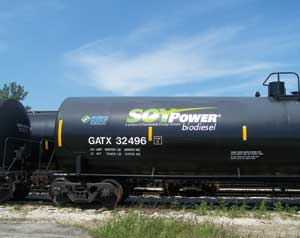Moving Biodiesel





January 17, 2008
BY Anduin Kirkbride McElroy
Getting product to the customer is a crucial aspect of any business, but biodiesel has special challenges that must be considered. The three primary ways to transport biodiesel are truck, rail and barge. Additionally, ships are used to transport large amounts of biodiesel between continents, and pipelines are being explored as a more efficient means of transporting fuel across land to major markets. Tests of biodiesel blends continue to be run in various pipelines, but it is still far from being a mainstream method of transporting methyl esters. Until pipeline transportation is an option, the biodiesel industry will continue to rely on the rail and barge system to transport its product long distances.
Short distance transportation is, and will continue to be, dominated by trucks. While the basics sound simple, transportation experts tell Biodiesel Magazine that many factors must be evaluated when considering how to send each shipment. "There are several factors that go into determining which mode of transportation is most efficient," says Adam Sander, transportation manager for biodiesel producer and marketer Renewable Energy Group Inc. "This includes the origin of the facility, destination, if the receiver is serviced by rail and the volume the customer can handle. Trucks hold 6,600 to 7,200 gallons, a railcar holds 23,000 to 26,000 gallons and barges hold 400,000 gallons. So you figure each railcar on average holds four truckloads. Each barge represents a volume of 15 railcars or 60 trucks."
Narrow down the options with simple steps, says Mike Szady, vice president of supply at World Energy. First, both the shipping and the receiving ends must have the proper infrastructure in order to have a choice. "If one side can only offload trucks, then you don't have a choice," he says. "If both sides can handle both trucks and railcars, then you have a choice. Get quotes for that movement: go to a truck company and ask them to quote you to ship from one point to the next. Then get a rail quote, and compare the two.
In general, if it's more than 300 miles, you can bet that railcars will be cheaper. Probably in the same vein, if it's less than 50 miles, it's going to be trucks that are cheaper."
Costs can vary widely, depending on distance, volume and method. "We price on cents per gallon," says Bill Neese, director of transportation and logistics for REG. "You can move a railcar 2 ½ times the distance that you can move a truck for the same per gallon price. The cost to move a truck 300 miles is the same cost per gallon to move a railcar 2 ½ to three times as far. For that same cost per gallon, you can move a barge from the Midwest to the Gulf."
Of course, these cost rationales assume full volumes. "If you go to railcar because the truck is too expensive, but you only have 10,000 gallons, is the volume of scale right to go from a truck to a railcar?" Szady asks. hypothetically. "Can I make other sales in that area to go to a railcar?"
Distribution makes up between 5 percent and 10 percent of the end product's cost, Szady says. Feedstock costs are about 80 percent to 85 percent and manufacturing costs make up the remaining 15 percent. "[The cost of distribution] could be next to nothing, but it won't be much more than 10 percent of the final cost of B100," he says.
Cost is certainly not the only factor when choosing a distribution method. The timing is also an important consideration. Trucks are obviously the most flexible method, and offer faster pick-up and delivery scheduling. Trains, meanwhile, require an average of six weeks to make a roundtrip.
The majority of biodiesel in the United States is shipped via rail, followed by truck and then finally barge, Szady says. While rail access isn't necessary to sell product, he says it offers an advantage to reach markets beyond the approximately 300-mile radius in which truck distribution is efficient. He explains that the typical 30 MMgy plant will have a 150-railcar-fleet. Each car will be insulated and coiled and can carry about 23,000 gallons. Ten percent of these cars will be used to carry glycerin. If feedstock delivery is also required, the fleet size should be doubled, Szady says.
REG manages transportation logistics for seven producing plants and three plants under construction, all of which have (or will have) rail access. In one year, it has doubled the amount of fuel for which it oversees distribution. About 70 percent of REG's transportation is on rail, 15 percent is on truck that REG schedules, and the remaining 15 percent is hauled out on truck from the production plant by the customers, Neese says. "As we see our railcar volumes grow, railcar management has become very vital to our operations," Sander says, referring to a long daily checklist required to monitor where railcars are, manage turn time and keep product moving.
Because trains are so integral to the transportation plan of the company, those at REG say it's important to ensure that rail access is one of the top priorities for a plant in development. "As soon as a customer [of REG's marketing division] indicates a desire to build a plant, we get involved," Neese says. "We establish rail carriers, rail service, truckers-even as far as the terminals to make sure that production from this plant will have a place to go to the terminal and distribution."
It is also important to order railcars early. Until recently, there was a 12- to 18-month lead time from when the order was placed with the leasing company until the time a biodiesel facility received its railcars. "Now there are cars already built and available," Neese says. "This is due to the decrease in production [of biodiesel]. Orders were placed based on anticipated production 12 to 18 months ago, assuming that all plants would be built." Though railcars are now more readily available, gaining access on rail lines is still a challenge, as rail infrastructure is near capacity, Neese says. "As we bring additional business to the rail in the form of biofuels, there is limited room for them to expand," he says. "We're probably bringing production and volume on faster than they can increase capacity to handle it. You can't just build it and expect that they'll come with the train. You have to talk to them at the very onset to make sure the line you're considering has the ability to handle the increased capacity."
Unit-Train Economics
As efficient and economical as rail is, it could be even more so when cars are moved as part of a unit train. A unit train typically consists of approximately 100 cars shipped from a single origin or gathering location to the same destination. The ethanol industry currently utilizes the unit trains to get large amounts of fuel from the Midwest to markets in California more cheaply and efficiently. In 2003, Burlington Northern Santa Fe Railway Co. developed the industry's first ethanol unit-train service, Ethanol Express. The program is designed to save producers time and money through increased fleet utilization, lower inventory carrying costs and logistics coordination. BNSF moves more than 223 million gallons of ethanol per year on its Ethanol Express.
At this point, Szady and Neese agree that moving biodiesel on unit trains doesn't make sense. The majority of biodiesel on rail is added to other units, up to eight cars at one time, Szady explains. Although he agrees that ultimately it will be good for the industry to be able to ship on unit trains, he says his company hasn't looked at it seriously because the market size isn't there. "Most of the larger biodiesel plants have a capacity of 30 MMgy, which is about 2.5 million gallons per month," Neese says. "A unit train of 100 cars holds 2.5 million gallons. Biodiesel plants aren't scaled the same as ethanol plants. To further complicate it, you don't have distribution on the other end that can accept that large of volume."
What if there was a central gathering place, such as a transload facility that had the tank capacity for unit trains? "We've looked into that, however you're doing an extra handling process there," Neese says. "All of our plants are set up to rail direct. Again, with unit trains, you're requiring someone to have the capability to have that large of volume in the receiving end. Currently, we don't have that large size. We're hoping in the near future we'll see it. It could be a refinery or a terminal with access to pipeline."
As the market for biodiesel within the United States has struggled over the past year, many producers have shifted to export markets. This has dramatically increased the amount of biodiesel that is shipped via rail to the ports, Sander says. Szady agrees that rail, rather than barge, has been the primary method to get fuel to export. "The main way to get it to export from the center of the country is by rail to water-based tankage on the coast," he says. "The reason you do that over barge is supply chain. Compare taking railcars to Houston with trucking it to the Mississippi River to a barge and then end up at the tank. Export parcels are very large-2,500, 5,000 or 10,000 metric tons are going at once. That's larger than any single barge. It's easier to take the tankage by rail. Some do go by barge because it's cheaper, but the barge market is tight. The majority [of transportation] is railing it by tank and shipping. There are few biodiesel plants on the Mississippi River that have the ability to load onto a barge."
Generally, barges are used just for feedstocks, but they are also an option to move fuel within the Mississippi River system. "In general, moving something down the Mississippi to New Orleans or Houston will be cheaper to move it by barge than rail," Szady says. In addition to limited barge access, scale and seasonal challenges make barge the least used transportation mode.
Transportation Challenges
Neese, who previously handled distribution in agricultural products, says biodiesel has unique properties that make it a more challenging product to transport-regardless of the method used. "The nature of the product is that it's temperature sensitive, especially in cold weather months, whereas with grain products you don't deal with those factors."
Another major challenge within all modes of transportation is maintaining product quality. "Because REG is a BQ- 9000 certified producer, we're responsible to maintain quality throughout distribution," Sander says. "That includes making sure we have all appropriate equipment and handling to maintain quality." Szady agrees that quality control goes far beyond the plant. "Every time you transfer your product, there's a risk that your quality can get compromised," he says. "Every time you take product from your tank and offload it, there's a chance something can happen to the product because you're doing something with it." Sampling and analyzing the product each step of the way and maintaining the right paperwork is how quality is maintained.
Finally, as the above transportation experts have described, the most efficient methods of transportation mean nothing if the customer cannot handle the equipment or volume. This is where it's important that customers have biodiesel-compatible tankage. Szady says terminals and terminal operators are investing in additional tankage in general, but he says they usually aren't biodiesel specific unless it's for a specific customer. Long-term leases can help encourage a terminal to invest in such infrastructure. Tankage allows a producer or marketer to accumulate inventory, which can open it up to more marketing and distribution options.
Anduin Kirkbride McElroy is a Biodiesel Magazine staff writer. Reach her at amcelroy@bbibiofuels.com or (701) 738-4962.
Short distance transportation is, and will continue to be, dominated by trucks. While the basics sound simple, transportation experts tell Biodiesel Magazine that many factors must be evaluated when considering how to send each shipment. "There are several factors that go into determining which mode of transportation is most efficient," says Adam Sander, transportation manager for biodiesel producer and marketer Renewable Energy Group Inc. "This includes the origin of the facility, destination, if the receiver is serviced by rail and the volume the customer can handle. Trucks hold 6,600 to 7,200 gallons, a railcar holds 23,000 to 26,000 gallons and barges hold 400,000 gallons. So you figure each railcar on average holds four truckloads. Each barge represents a volume of 15 railcars or 60 trucks."
Narrow down the options with simple steps, says Mike Szady, vice president of supply at World Energy. First, both the shipping and the receiving ends must have the proper infrastructure in order to have a choice. "If one side can only offload trucks, then you don't have a choice," he says. "If both sides can handle both trucks and railcars, then you have a choice. Get quotes for that movement: go to a truck company and ask them to quote you to ship from one point to the next. Then get a rail quote, and compare the two.
In general, if it's more than 300 miles, you can bet that railcars will be cheaper. Probably in the same vein, if it's less than 50 miles, it's going to be trucks that are cheaper."
Costs can vary widely, depending on distance, volume and method. "We price on cents per gallon," says Bill Neese, director of transportation and logistics for REG. "You can move a railcar 2 ½ times the distance that you can move a truck for the same per gallon price. The cost to move a truck 300 miles is the same cost per gallon to move a railcar 2 ½ to three times as far. For that same cost per gallon, you can move a barge from the Midwest to the Gulf."
Of course, these cost rationales assume full volumes. "If you go to railcar because the truck is too expensive, but you only have 10,000 gallons, is the volume of scale right to go from a truck to a railcar?" Szady asks. hypothetically. "Can I make other sales in that area to go to a railcar?"
Distribution makes up between 5 percent and 10 percent of the end product's cost, Szady says. Feedstock costs are about 80 percent to 85 percent and manufacturing costs make up the remaining 15 percent. "[The cost of distribution] could be next to nothing, but it won't be much more than 10 percent of the final cost of B100," he says.
Cost is certainly not the only factor when choosing a distribution method. The timing is also an important consideration. Trucks are obviously the most flexible method, and offer faster pick-up and delivery scheduling. Trains, meanwhile, require an average of six weeks to make a roundtrip.
The majority of biodiesel in the United States is shipped via rail, followed by truck and then finally barge, Szady says. While rail access isn't necessary to sell product, he says it offers an advantage to reach markets beyond the approximately 300-mile radius in which truck distribution is efficient. He explains that the typical 30 MMgy plant will have a 150-railcar-fleet. Each car will be insulated and coiled and can carry about 23,000 gallons. Ten percent of these cars will be used to carry glycerin. If feedstock delivery is also required, the fleet size should be doubled, Szady says.
REG manages transportation logistics for seven producing plants and three plants under construction, all of which have (or will have) rail access. In one year, it has doubled the amount of fuel for which it oversees distribution. About 70 percent of REG's transportation is on rail, 15 percent is on truck that REG schedules, and the remaining 15 percent is hauled out on truck from the production plant by the customers, Neese says. "As we see our railcar volumes grow, railcar management has become very vital to our operations," Sander says, referring to a long daily checklist required to monitor where railcars are, manage turn time and keep product moving.
Because trains are so integral to the transportation plan of the company, those at REG say it's important to ensure that rail access is one of the top priorities for a plant in development. "As soon as a customer [of REG's marketing division] indicates a desire to build a plant, we get involved," Neese says. "We establish rail carriers, rail service, truckers-even as far as the terminals to make sure that production from this plant will have a place to go to the terminal and distribution."
It is also important to order railcars early. Until recently, there was a 12- to 18-month lead time from when the order was placed with the leasing company until the time a biodiesel facility received its railcars. "Now there are cars already built and available," Neese says. "This is due to the decrease in production [of biodiesel]. Orders were placed based on anticipated production 12 to 18 months ago, assuming that all plants would be built." Though railcars are now more readily available, gaining access on rail lines is still a challenge, as rail infrastructure is near capacity, Neese says. "As we bring additional business to the rail in the form of biofuels, there is limited room for them to expand," he says. "We're probably bringing production and volume on faster than they can increase capacity to handle it. You can't just build it and expect that they'll come with the train. You have to talk to them at the very onset to make sure the line you're considering has the ability to handle the increased capacity."
Unit-Train Economics
As efficient and economical as rail is, it could be even more so when cars are moved as part of a unit train. A unit train typically consists of approximately 100 cars shipped from a single origin or gathering location to the same destination. The ethanol industry currently utilizes the unit trains to get large amounts of fuel from the Midwest to markets in California more cheaply and efficiently. In 2003, Burlington Northern Santa Fe Railway Co. developed the industry's first ethanol unit-train service, Ethanol Express. The program is designed to save producers time and money through increased fleet utilization, lower inventory carrying costs and logistics coordination. BNSF moves more than 223 million gallons of ethanol per year on its Ethanol Express.
At this point, Szady and Neese agree that moving biodiesel on unit trains doesn't make sense. The majority of biodiesel on rail is added to other units, up to eight cars at one time, Szady explains. Although he agrees that ultimately it will be good for the industry to be able to ship on unit trains, he says his company hasn't looked at it seriously because the market size isn't there. "Most of the larger biodiesel plants have a capacity of 30 MMgy, which is about 2.5 million gallons per month," Neese says. "A unit train of 100 cars holds 2.5 million gallons. Biodiesel plants aren't scaled the same as ethanol plants. To further complicate it, you don't have distribution on the other end that can accept that large of volume."
What if there was a central gathering place, such as a transload facility that had the tank capacity for unit trains? "We've looked into that, however you're doing an extra handling process there," Neese says. "All of our plants are set up to rail direct. Again, with unit trains, you're requiring someone to have the capability to have that large of volume in the receiving end. Currently, we don't have that large size. We're hoping in the near future we'll see it. It could be a refinery or a terminal with access to pipeline."
As the market for biodiesel within the United States has struggled over the past year, many producers have shifted to export markets. This has dramatically increased the amount of biodiesel that is shipped via rail to the ports, Sander says. Szady agrees that rail, rather than barge, has been the primary method to get fuel to export. "The main way to get it to export from the center of the country is by rail to water-based tankage on the coast," he says. "The reason you do that over barge is supply chain. Compare taking railcars to Houston with trucking it to the Mississippi River to a barge and then end up at the tank. Export parcels are very large-2,500, 5,000 or 10,000 metric tons are going at once. That's larger than any single barge. It's easier to take the tankage by rail. Some do go by barge because it's cheaper, but the barge market is tight. The majority [of transportation] is railing it by tank and shipping. There are few biodiesel plants on the Mississippi River that have the ability to load onto a barge."
Generally, barges are used just for feedstocks, but they are also an option to move fuel within the Mississippi River system. "In general, moving something down the Mississippi to New Orleans or Houston will be cheaper to move it by barge than rail," Szady says. In addition to limited barge access, scale and seasonal challenges make barge the least used transportation mode.
Transportation Challenges
Neese, who previously handled distribution in agricultural products, says biodiesel has unique properties that make it a more challenging product to transport-regardless of the method used. "The nature of the product is that it's temperature sensitive, especially in cold weather months, whereas with grain products you don't deal with those factors."
Another major challenge within all modes of transportation is maintaining product quality. "Because REG is a BQ- 9000 certified producer, we're responsible to maintain quality throughout distribution," Sander says. "That includes making sure we have all appropriate equipment and handling to maintain quality." Szady agrees that quality control goes far beyond the plant. "Every time you transfer your product, there's a risk that your quality can get compromised," he says. "Every time you take product from your tank and offload it, there's a chance something can happen to the product because you're doing something with it." Sampling and analyzing the product each step of the way and maintaining the right paperwork is how quality is maintained.
Finally, as the above transportation experts have described, the most efficient methods of transportation mean nothing if the customer cannot handle the equipment or volume. This is where it's important that customers have biodiesel-compatible tankage. Szady says terminals and terminal operators are investing in additional tankage in general, but he says they usually aren't biodiesel specific unless it's for a specific customer. Long-term leases can help encourage a terminal to invest in such infrastructure. Tankage allows a producer or marketer to accumulate inventory, which can open it up to more marketing and distribution options.
Anduin Kirkbride McElroy is a Biodiesel Magazine staff writer. Reach her at amcelroy@bbibiofuels.com or (701) 738-4962.
Advertisement
Advertisement
Advertisement
Advertisement
Upcoming Events





